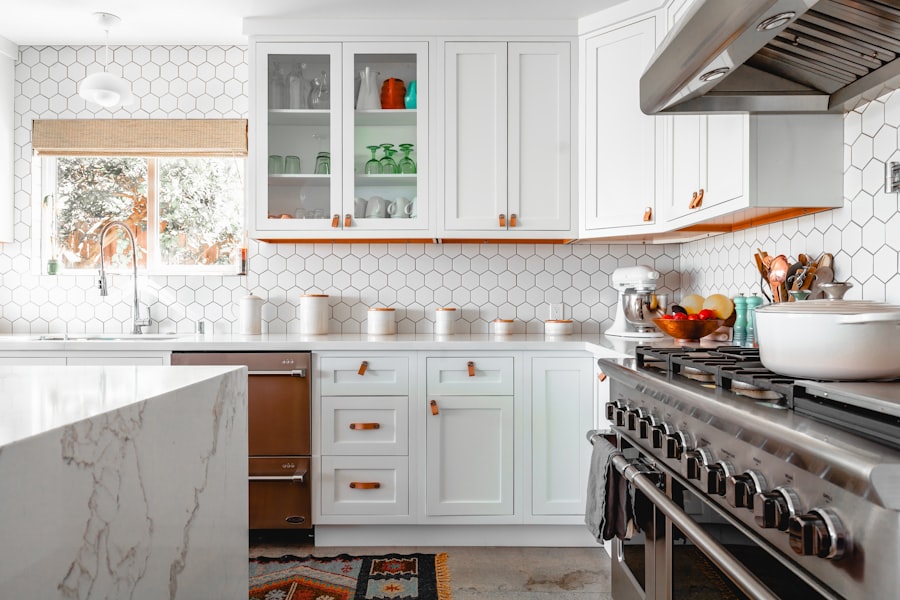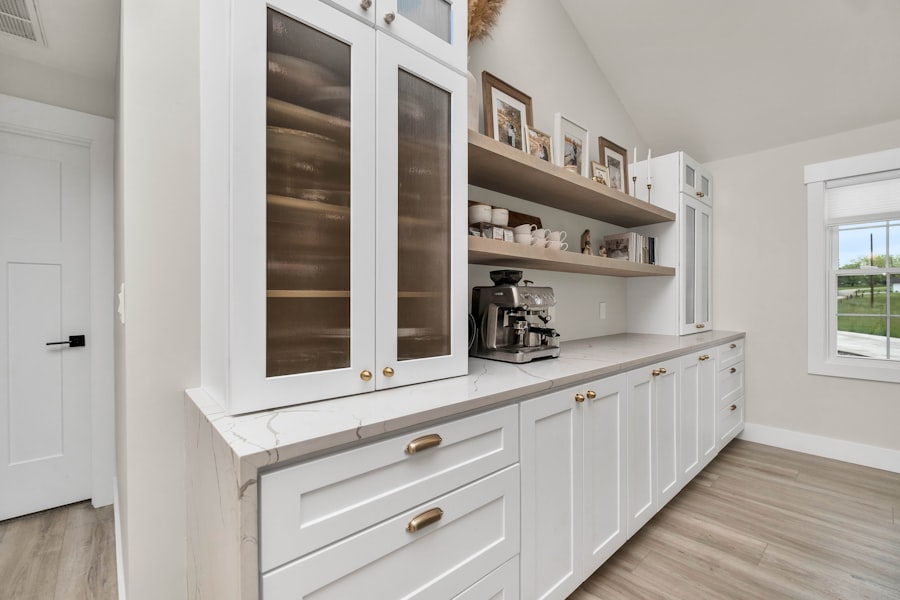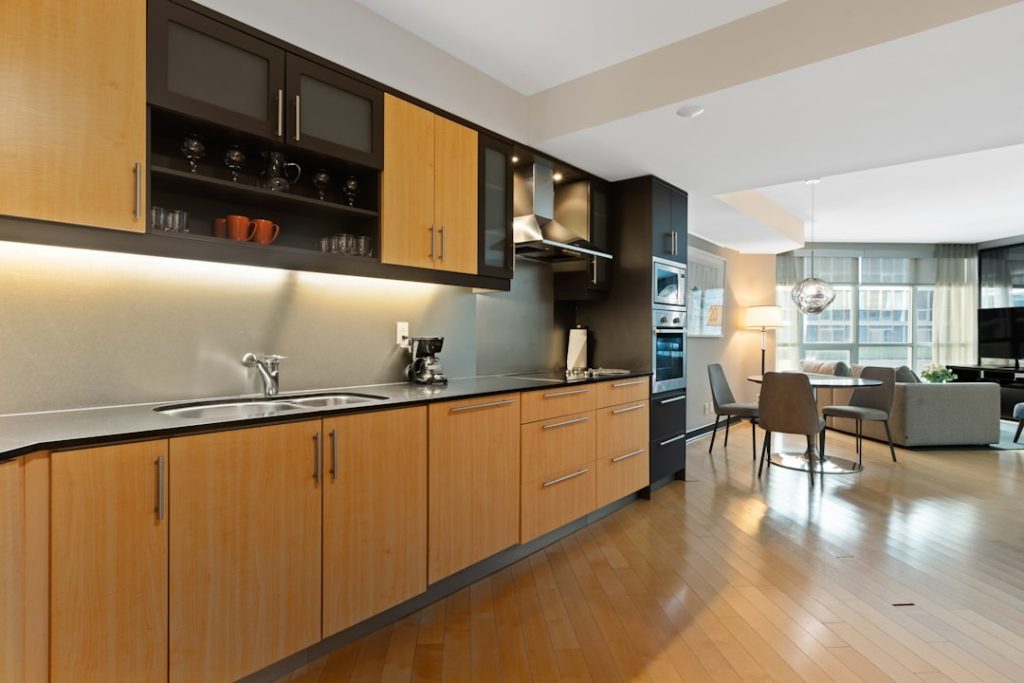Custom kitchen cabinets play a pivotal role in the overall functionality and aesthetic appeal of a kitchen. Unlike stock cabinets, which are mass-produced and often limited in design and size, custom cabinets are tailored to meet the specific needs and preferences of the homeowner. This personalization allows for a more efficient use of space, particularly in kitchens with unique layouts or dimensions.
For instance, a custom cabinet can be designed to fit snugly into an awkward corner or to accommodate specific appliances, ensuring that every inch of space is utilized effectively. This level of customization not only enhances the kitchen’s usability but also contributes to a cohesive design that reflects the homeowner’s style. Moreover, custom kitchen cabinets can significantly increase the value of a home.
Potential buyers often view a well-designed kitchen as a major selling point, and high-quality cabinetry can make a lasting impression. Custom cabinets are typically constructed from superior materials and craftsmanship compared to their pre-fabricated counterparts, which can lead to greater durability and longevity. This investment in quality can yield substantial returns when it comes time to sell the property.
Additionally, the ability to choose finishes, colors, and styles that resonate with current design trends can further elevate the kitchen’s appeal, making it a focal point in the home.
Key Takeaways
- Custom kitchen cabinets enhance both the functionality and aesthetic appeal of your kitchen.
- Selecting durable and suitable materials is crucial for long-lasting custom cabinets.
- Thoughtful design maximizes space utilization and improves kitchen workflow.
- Collaborating with a professional cabinet maker ensures quality craftsmanship and personalized solutions.
- Regular maintenance helps preserve the beauty and durability of custom kitchen cabinets over time.
Choosing the Right Materials for Custom Kitchen Cabinets
Selecting the appropriate materials for custom kitchen cabinets is crucial for achieving both durability and aesthetic appeal. The most common materials used in cabinet construction include solid wood, plywood, particleboard, and medium-density fiberboard (MDF). Solid wood is often favored for its natural beauty and strength; species such as oak, maple, cherry, and walnut offer distinct grain patterns and colors that can enhance the overall design of the kitchen.
However, solid wood can be susceptible to warping and expansion due to humidity changes, so it’s essential to consider the kitchen’s environment when making this choice. Plywood is another popular option for custom cabinets due to its stability and resistance to warping. It is made from layers of wood veneer glued together, which provides strength while being lighter than solid wood.
Plywood can be an excellent choice for cabinet boxes, while solid wood can be reserved for doors and face frames. On the other hand, particleboard and MDF are often used for budget-friendly projects. While these materials are less expensive and can be finished to look like wood, they may not offer the same level of durability or longevity as solid wood or plywood.
Ultimately, the choice of material should align with the homeowner’s budget, desired aesthetic, and functional requirements.
Designing Custom Kitchen Cabinets to Maximize Space and Functionality

The design of custom kitchen cabinets should prioritize both space optimization and functionality. One effective approach is to incorporate various cabinet styles that cater to different storage needs. For example, deep drawers can be designed for pots and pans, while pull-out shelves can provide easy access to spices or canned goods.
Additionally, vertical storage solutions such as tall cabinets or pantry units can help maximize vertical space in smaller kitchens. By utilizing every available inch, homeowners can create a more organized and efficient cooking environment. Another important aspect of cabinet design is the layout in relation to the kitchen work triangle—the optimal distance between the sink, stove, and refrigerator.
Custom cabinets can be strategically placed to facilitate smooth workflow during meal preparation. For instance, placing a pull-out cutting board near the stove or integrating a built-in microwave at counter height can enhance convenience. Furthermore, incorporating open shelving or glass-front cabinets can create visual interest while providing easy access to frequently used items.
Thoughtful design choices not only improve functionality but also contribute to a more enjoyable cooking experience.
Working with a Professional Cabinet Maker for Custom Kitchen Cabinets
| Metric | Description | Typical Range | Importance |
|---|---|---|---|
| Customization Level | Degree to which cabinets are tailored to specific design and space requirements | High (Fully custom to semi-custom) | Very High |
| Material Quality | Type and grade of wood or materials used for cabinet construction | Medium to Premium | High |
| Lead Time | Time from design approval to cabinet installation | 4 to 12 weeks | Medium |
| Design Consultation Hours | Time spent collaborating with the cabinet maker on design details | 2 to 6 hours | High |
| Warranty Period | Duration of warranty coverage for workmanship and materials | 1 to 5 years | Medium |
| Installation Accuracy | Precision of cabinet fitting and alignment during installation | 95% to 100% | Very High |
| Customer Satisfaction Rate | Percentage of clients satisfied with the final product and service | 85% to 98% | Very High |
| Cost Efficiency | Value for money considering quality and customization | Varies by project | High |
Collaborating with a professional cabinet maker is essential for achieving high-quality custom kitchen cabinets that meet specific design requirements. A skilled cabinet maker brings expertise in woodworking techniques, material selection, and design principles that can elevate the final product. When selecting a cabinet maker, it’s important to review their portfolio and seek recommendations from previous clients to ensure they have a proven track record of delivering exceptional results.
During the design process, effective communication with the cabinet maker is crucial. Homeowners should articulate their vision clearly while being open to suggestions based on the cabinet maker’s experience. This collaboration often involves discussing layout options, material choices, finishes, and hardware selections.
A professional cabinet maker will also take precise measurements of the kitchen space to ensure that the cabinets fit perfectly within the designated area. By working closely with an expert, homeowners can navigate potential challenges and create a cohesive design that aligns with their lifestyle and preferences.
Customizing Cabinet Doors and Hardware for a Personalized Look
The doors and hardware of custom kitchen cabinets significantly influence their overall appearance and style. Homeowners have a plethora of options when it comes to door styles—ranging from traditional raised panel designs to sleek flat-panel or shaker styles. Each style conveys a different aesthetic; for instance, raised panel doors may evoke a classic or rustic feel, while flat-panel doors lend themselves to modern or minimalist designs.
Choosing the right door style is essential for achieving the desired look while ensuring that it complements other elements in the kitchen. In addition to door styles, hardware selection plays a vital role in personalizing custom cabinets. Knobs and pulls come in various materials such as brass, stainless steel, or ceramic, each offering distinct visual characteristics.
The choice of hardware should harmonize with the overall design theme; for example, vintage-style knobs may suit a farmhouse kitchen, while sleek metal pulls may be more appropriate for contemporary spaces. Furthermore, homeowners can consider unique finishes or custom designs for hardware to add an extra layer of personalization. By thoughtfully selecting door styles and hardware, homeowners can create custom cabinets that reflect their individual tastes while enhancing the kitchen’s overall aesthetic.
Incorporating Special Features and Accessories in Custom Kitchen Cabinets

Custom kitchen cabinets offer an opportunity to integrate special features and accessories that enhance both functionality and convenience. One popular addition is built-in organizers such as pull-out spice racks or utensil trays that keep essential items easily accessible while maintaining an organized appearance. These features not only streamline cooking processes but also contribute to a clutter-free countertop.
Another innovative option is incorporating lighting within the cabinetry. Under-cabinet lighting can illuminate workspaces effectively while adding ambiance to the kitchen. LED strips or puck lights installed inside glass-front cabinets can showcase dishware or decorative items beautifully.
Additionally, features like lazy Susans or pull-out pantry shelves maximize storage efficiency by allowing easy access to items stored in deep corners or high shelves. By considering these special features during the design phase, homeowners can create custom cabinets that cater specifically to their cooking habits and lifestyle needs.
Budgeting and Planning for Custom Kitchen Cabinets
Budgeting for custom kitchen cabinets requires careful planning and consideration of various factors that influence costs. The first step is determining a realistic budget based on individual financial circumstances while accounting for potential additional expenses such as installation or finishing touches. Custom cabinetry typically costs more than stock options due to its personalized nature; however, understanding where funds will be allocated can help homeowners make informed decisions.
Material selection plays a significant role in budgeting; opting for high-quality materials may increase upfront costs but can lead to long-term savings through durability and reduced maintenance needs. Additionally, labor costs associated with hiring skilled cabinet makers should be factored into the budget. Homeowners should also consider timelines; custom cabinetry often requires longer lead times than pre-fabricated options due to the bespoke nature of production.
By establishing a clear budget and timeline from the outset, homeowners can navigate the process more effectively while ensuring they achieve their desired results without overspending.
Maintaining and Caring for Custom Kitchen Cabinets
Proper maintenance is essential for preserving the beauty and functionality of custom kitchen cabinets over time. Regular cleaning is crucial; using a soft cloth with mild soap and water can help remove dirt and grease without damaging finishes. Homeowners should avoid harsh chemicals or abrasive cleaners that could scratch surfaces or strip protective coatings.
Additionally, it’s advisable to periodically check hinges and drawer slides for any signs of wear or misalignment; addressing these issues promptly can prevent more significant problems down the line. Humidity control is another critical aspect of maintaining custom cabinets, particularly those made from wood. Excessive moisture can lead to warping or swelling; therefore, using dehumidifiers in humid climates or ensuring proper ventilation in kitchens can help mitigate these risks.
For painted or stained finishes, applying a fresh coat every few years can rejuvenate their appearance while providing an extra layer of protection against wear and tear. By implementing these maintenance practices, homeowners can ensure their custom kitchen cabinets remain functional and visually appealing for years to come.



